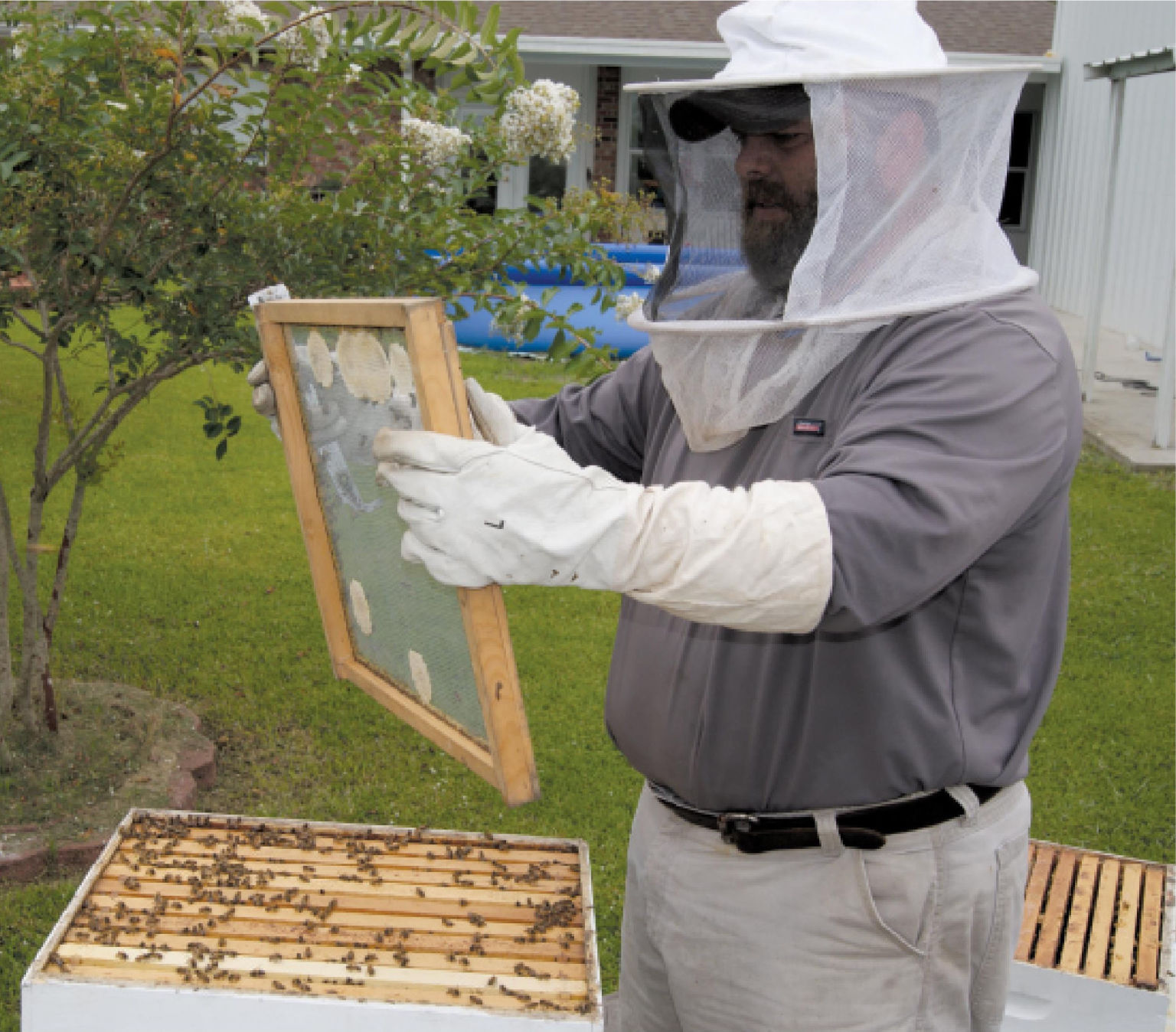
A BATTLE WON, BUT NOT THE WAR
July 28, 2018
Arlene DeHart
July 28, 2018Like others working side-jobs in the new gig economy, Matt Falgout of Houma is turning what was a hobby into profit.
A track and football coach as well a health and physical education teacher, Matt began bee-keeping 2 years ago. Behind his house, past a cluster of crepe myrtles, three beehives stand on a porch that overlooks Bayou Terrebonne.
“To make extra money; well, and also to have a hobby,” said Matt. “I wanted to do something that I like doing – I like to build things – and something that I can get a little bit out of. I like to fish and hunt, but you spend money, you don’t get nothing to retire on.”
Donning his protective jacket, gloves, and hat, Matt grabbed his smoker and headed toward the three hives, which are among 29 that he maintains overall. Twenty-six are on another property.
“The reason you want to check on them around noon is because all the bees are out,” he said pointing at a few bees on his crepe myrtles’ flowers. “You’re not messing with the whole she-bang.”
The smoker is a small metal can with a spout on the top. On the back is a bellows which resembles that of an accordion. Matt packed the smoker with fuel, a mixture of pine needles, a pine cone, and a burlap sack. He said anything could be used to smoke them, so long as it wasn’t poisonous. He also said he prefers not to smoke the bees. But the combination of on-coming rain and a, convinced him to err on the side of caution.
Opening the tallest of his hive boxes, 5 layers high, Matt began squeezing the bellows to smoke the bees. As each puff dissipated, gold and black rumps could be seen scurrying deeper into the box. Asked how many bees were in the hive, Matt said he didn’t know.
He was quickly scanning the box to ensure the queen wasn’t near the top. When bees become too cramped in their homes, the hive will prepare to swarm in search of larger accommodations.
To prevent this, Matt had another layer to add to the box. This layer is known as a “supe,” he said, but there are also three other types of layers which comprise the hives.
“Anything that you put honey in I guess you could call a supe. This is a medium” said Matt, pointing at a box about the size of a filing cabinet drawer. “This is a deep: this is where your brood goes in, and this is a shallow: a shallow you can also use for honey, but it fills it up faster than a medium because it’s small.”
On the front of the hive, on the very bottom box, was a rectangular hole which bees could be seen entering and exiting, pollen covering their back-leg joints. In front of it, Matt had installed a “queen excluder” which resembles a plastic comb. The spaces between the teeth allowed all but the queen to pass. As long as she doesn’t leave, the colony stays put, Matt said.
According to Matt, the bee’s gathering season, or “honey-flow” as he called it, is over, so no honey was harvested from his hives that day.
He had gathered 20 gallons of honey a few days prior, indicated by the equipment he uses for processing.
The back porch was permeated with the smell of honey. On a small dolly were racks which he had spun dry with a centrifuge.
The racks are rectangular screens housed inside the “supes.” The bees line the screens with wax to form combs and then fill the combs with honey.
The centrifuge spins the racks at a very high speed which forces the honey to the sides of the machine, while the racks stay in the center.
“This is a small one,” Matt said of the centrifuge. “I need to get a bigger one next year.”
Having finished with his morning chores, Matt took off the suit and went into his workshop to have a soda and cool off.
Inside Matt’s workshop stacks of “supes” towered over him. Even though he occasionally purchases the structures used for his hives, Matt often crafts them himself.
He showed off one box with a screen in the bottom, noting that he can hook a vacuum up to it for easy collection of loose hives.
Small tricks like this are traded and improved upon within the beekeeping community, he said.
“That’s what the whole thing’s about. You get ideas from other people,” Matt said.
He expects the community to continue growing over the next five to ten years but isn’t giving up yet.
“I used to want to make extra money with this, Matt said, as he prepared to head out and bring his honey to the South Louisiana Feed Store in Houma. “But I’ll always say I got into it in the wrong time because everybody else was getting into it.”
Matt Falgout, of Houma, is turning what was a hobby into a profit Here, he checks his bee hive for honey last Monday morning.








